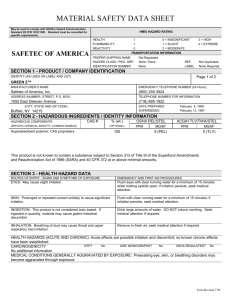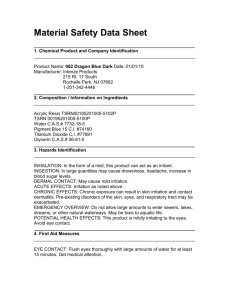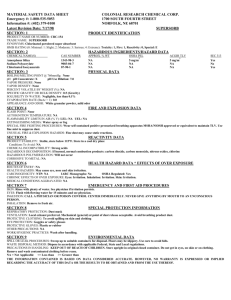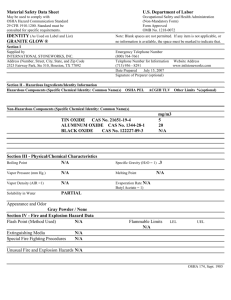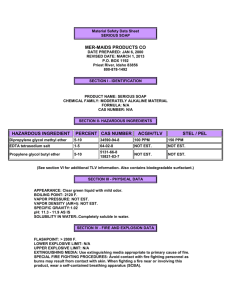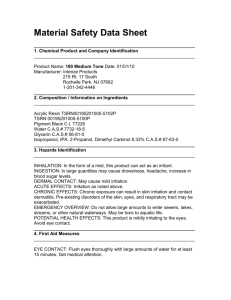Chlor Foam MSDS - The Buying Network
advertisement
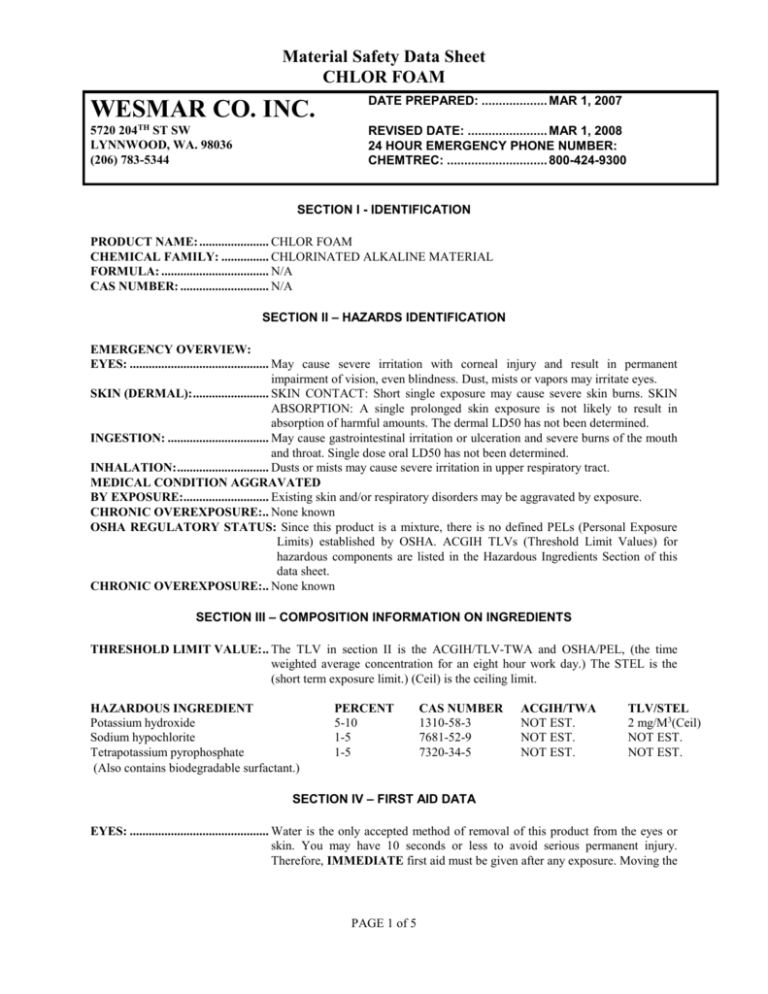
Material Safety Data Sheet CHLOR FOAM WESMAR CO. INC. DATE PREPARED: ................... MAR 1, 2007 5720 204TH ST SW LYNNWOOD, WA. 98036 (206) 783-5344 REVISED DATE: ....................... MAR 1, 2008 24 HOUR EMERGENCY PHONE NUMBER: CHEMTREC: ............................. 800-424-9300 SECTION I - IDENTIFICATION PRODUCT NAME: ...................... CHLOR FOAM CHEMICAL FAMILY: ............... CHLORINATED ALKALINE MATERIAL FORMULA: .................................. N/A CAS NUMBER: ............................ N/A SECTION II – HAZARDS IDENTIFICATION EMERGENCY OVERVIEW: EYES: ............................................ May cause severe irritation with corneal injury and result in permanent impairment of vision, even blindness. Dust, mists or vapors may irritate eyes. SKIN (DERMAL): ........................ SKIN CONTACT: Short single exposure may cause severe skin burns. SKIN ABSORPTION: A single prolonged skin exposure is not likely to result in absorption of harmful amounts. The dermal LD50 has not been determined. INGESTION: ................................ May cause gastrointestinal irritation or ulceration and severe burns of the mouth and throat. Single dose oral LD50 has not been determined. INHALATION: ............................. Dusts or mists may cause severe irritation in upper respiratory tract. MEDICAL CONDITION AGGRAVATED BY EXPOSURE:........................... Existing skin and/or respiratory disorders may be aggravated by exposure. CHRONIC OVEREXPOSURE:.. None known OSHA REGULATORY STATUS: Since this product is a mixture, there is no defined PELs (Personal Exposure Limits) established by OSHA. ACGIH TLVs (Threshold Limit Values) for hazardous components are listed in the Hazardous Ingredients Section of this data sheet. CHRONIC OVEREXPOSURE:.. None known SECTION III – COMPOSITION INFORMATION ON INGREDIENTS THRESHOLD LIMIT VALUE: .. The TLV in section II is the ACGIH/TLV-TWA and OSHA/PEL, (the time weighted average concentration for an eight hour work day.) The STEL is the (short term exposure limit.) (Ceil) is the ceiling limit. HAZARDOUS INGREDIENT Potassium hydroxide Sodium hypochlorite Tetrapotassium pyrophosphate (Also contains biodegradable surfactant.) PERCENT 5-10 1-5 1-5 CAS NUMBER 1310-58-3 7681-52-9 7320-34-5 ACGIH/TWA NOT EST. NOT EST. NOT EST. TLV/STEL 2 mg/M3(Ceil) NOT EST. NOT EST. SECTION IV – FIRST AID DATA EYES: ............................................ Water is the only accepted method of removal of this product from the eyes or skin. You may have 10 seconds or less to avoid serious permanent injury. Therefore, IMMEDIATE first aid must be given after any exposure. Moving the PAGE 1 of 5 Material Safety Data Sheet CHLOR FOAM victim from water access for transport to medical aid should be done only on the advice of qualified medical personnel. While transporting victim to a medical facility, continue washing if possible. In case of contact, immediately flush eyes with lots of running water for at least 15 minutes. Call for medical assistance. In case of contact, immediately flush eyes with lots of running water for at least 15 minutes. Call for medical assistance. SKIN (DERMAL): ........................ Wash exposed area with plenty of water. Repeat washing. Remove contaminated clothing and wash thoroughly before reuse. If irritation persists consult a health care professional. INGESTION: ................................ DO NOT INDUCE VOMITING. Rinse with copious amounts of water or milk, first. Irrigate the esophagus and dilute stomach contents by slowly giving one to two glasses of water or milk. Avoid alcohol or alcohol related products. In cases where the individual is semi-comatose, comatose or convulsing, DO NOT GIVE FLUIDS BY MOUTH. In case of intentional ingestion of the product seek medical assistance immediately; take individual to nearest medical facility. INHALATION: ............................. If exposure by inhalation is suspected, immediately move exposed individual to fresh air. If individual experiences nausea, headache, dizziness, has difficulty in breathing or is cyanotic, seek a health care professional immediately. Never give anything by mouth to an unconscious person. NOTE TO PHYSICIAN:.............. CORROSIVE! May cause stricture. If lavage is performed, suggest endotracheal and/or esophagoscopic control. Material is strong alkali. If burn is present, treat as any thermal burn, after decontamination. For burns of skin only. Eye irrigation may be necessary for an extended period of time to remove as much caustic as possible. Duration of irrigation and treatment is at the discretion of medical personnel. No specific antidote. Supportive care. Treatment based on judgment of the physician in response to reactions of the patient. SECTION V – FIRE FIGHTING MEASURES FLASHPOINT: ............................. Non flammable, non combustible. LOWER EXPLOSIVE LIMIT:... N/A UPPER EXPLOSIVE LIMIT:..... N/A EXTINGUISHING MEDIA: ....... Use extinguishing media appropriate to primary cause of fire. SPECIAL FIRE FIGHTING PROCEDURES: ........................... Avoid contact with fire fighting personnel as burns may result from contact with skin. When fighting a fire near or involving this product, wear a self-contained breathing apparatus (SCBA). UNUSUAL FIRE AND EXPLOSION HAZARDS: ........... None known SECTION VI – ACCIDENTAL RELEASE MEASURES SPILL: ........................................... Appropriate protective clothing must be worn by trained clean-up personnel. Dike the area to contain the spill. Dilute with large quantities of water and neutralize any residual chlorine with sodium thiosulfate or sodium sulfite. After all chlorine is neutralized, pH may be neutralized with dilute acid such as phosphoric, hydrochloric or sulfuric. Properly neutralized liquids (pH 6-9) may be disposed of in waste water treatment facilities. Check with local authorities first. PAGE 2 of 5 Material Safety Data Sheet CHLOR FOAM SECTION – VII HANDLING AND STORAGE HANDLING INFORMATION: .. Do not get in eyes, on skin or on clothing. Avoid breathing dust, mists, or spray. Do not take internally. Wash thoroughly after handling or contact. Exposure can cause burns that are not immediately painful or visible. Do not add water to contents while in container because of possible violent reaction. Keep out of sun and away from heat, sparks and flames. Keep container tightly closed when not in use to prevent leakage. Do not use pressure to empty container. Do not wash out container or use it for other purposes. Replace closure after each withdrawal and return it with empty container. Empty containers retain product residue and must be handled as if they were full. KEEP OUT OF REACH OF CHILDREN. STORAGE REQUIREMENTS: .. Keep containers tightly closed when not in use. Empty container completely and dispose of in accordance with applicable regulations. SECTION VIII – EXPOSURE CONTROLS / PERSONAL PROTECTION EYE PROTECTION: ................... Chemical safety splash goggles and full face shield (8” min.) to protect against splashing in compliance with OSHA regulations are advised. OSHA regulations also permit other type safety glasses. (Consult your industrial hygienist) Contact lenses should not be worn when working with any chemicals. RESPIRATORY PROTECTION: Respiratory protection should be worn if levels exceed defined PEL(s) for this product or any hazardous component listed in the Hazardous Ingredient Section of this DATA SHEET. PROTECTIVE CLOTHING: ...... Impervious protective clothing and chemical resistant safety shoes should be worn to minimize contact. Emergency shower and eyewash facility should be in close proximity. (ANSI Z358.1) VENTILATION:........................... Local exhaust sufficient to maintain TLV below permissible exposure limits. SECTION IX – PHYSICAL AND CHEMICAL PROPERTIES APPEARANCE: ........................... Clear light yellow liquid with mild odor BOILING POINT: ........................ ~212 F. VAPOR PRESSURE: ................... NOT EST. VAPOR DENSITY (AIR=1): ....... NOT EST. SPECIFIC GRAVITY:................. 1.15 pH: ................................................. > 13.5 SOLUBILITY IN WATER: ......... Completely soluble in water. SECTION X – STABILITY AND REACITIVITY DATA STABILITY: ................................. Stable INCOMPATIBILITY: ................. Avoid contact with aluminum, tin, zinc, bronze, brass and alloys containing these metals. Do not mix with acids or organic compounds due to possible violent reaction. Avoid contact with leather, wool, organic halogen and nitrogen compounds. HAZARDOUS DECOMPOSITION: .................... Chlorine, chlorine dioxide and chloramines. If decomposition occurs, it may cause container to rupture. HAZARDOUS POLYMERIZATION: ................. Will not occur. PAGE 3 of 5 Material Safety Data Sheet CHLOR FOAM SECTION XI – TOXICOLOGICAL INFORMATION TOXICITY EFFECTS: ................ POTASSIUM HYDROXIDE: Toxicity Data: This material will affect all tissues with which it comes in contact. The severity of the tissue damage is a function of concentration, the length of tissue contact time, and local tissue conditions. After exposure there may be a time delay before irritation and other effects occur. This material is a strong irritant and is corrosive to the skin, eyes, and mucous membranes. This material may cause severe burns and permanent damage to any tissue with which it comes into contact. Inhalation will cause severe irritation, possible burns with pulmonary edema, which may lead to pneumonitis. Skin contact with this material may cause severe irritation and corrosion with possible corneal damage and blindness. SODIUM HYPOCHLORITE: Irritation Data: 10 mg eyes-rabbit, moderate. Toxicity Data: 1 gm/kg oral-woman TDLo (Lowest published toxic dose), 45 mg/kg intravenous-man TDLo: LD50 oral rat – 8910 mg/kg. MUTAGENICITY: Sodium Hypochlorite caused mutations in several short-term studies using bacteria and cultured mammalian cells. The significance of these tests is unclear. It was not mutagenic in tests (chromosome aberration and micronucleus) on live animals. SECTION XII – ECOLOGICAL INFORMATION ECOLOGICAL INFORMATION: POTASSIUM HYDROXIDE: Fish Toxicity: This material has exhibited moderate toxicity to aquatic organisms. For potassium hydroxide: 80 mg/l (96 hr) LC50 Mosquito fish: 165 mg/l (24 hr) LC50 Guppy. PERSISTENCE: This material is alkaline and may raise the pH of surface waters with low buffering capacity. This material is believed to exist in the disassociated state in the environment. SODIUM HYPOCHLORITE: Fish Toxicity: LC50 (48 hr) rainbow trout 0.07 mg/l. LC50 (96 hr) fathead minnow 5.9 mg/l. Persistence and Degradation: No data available. Inorganic phosphates in contact with the soil, sub-surface and surface waters may be taken up by plants and utilized as essential nutrients. Phosphates may also form precipitates that are insoluble in water and become part of the soil or sediment. SECTION XIII – DISPOSAL CONSIDERATIONS WASTE DISPOSAL: .................... Consult all LOCAL, STATE, and FEDERAL regulations with regard to proper and suitable disposal methods. SECTION XIV – TRANSPORTATION INFORMATION HAZARD CLASS AND LABEL: 8 (CORROSIVE) PROPER SHIPPING NAME: .... POTASSIUM HYDROXIDE, SOLUTION 8 UN-1814 PG-II UN NUMBER: .............................. UN 1814 PACKAGING GROUP: ............... PG – II REPORTABLE QUANTITY: ..... 1000 LBS. (Based on Sodium or Potassium hydroxide content.) PAGE 4 of 5 Material Safety Data Sheet CHLOR FOAM SECTION XV – REGULATORY INFORMATION LISTED CARCINOGEN: ............ This product does not contain any components listed by NTP, IARC, or OSHA as carcinogens at the OSHA reportable levels. TSCA STATUS: ............................ All components in this product are listed on the TSCA inventory. SARA SECTION 313: .................. This product does not contain any EPCRA section 313 chemicals subject to the reporting requirements of section 313 of the Emergency Planning and Community Right-To-Know Act of 1986 (40CFR 372). NFPA HEALTH: .......................... 3 NFPA FLAMMABILITY: ........... 0 NFPA REACTIVITY: .................. 1 SECTION XVI – OTHER INFORMATION REFERENCES: ............................ The information contained herein has been compiled from sources believed to be reliable and accurate to the best of our knowledge at this date. It is provided without warranty, expressed or implied, as to the results of use of this information or to the product to which it relates. WESMAR CO. assumes no responsibility for injury to any person or property resulting from any use of the material. Each user assumes the risk in their use of this product and should review the data and recommendations in the specific context of their intended use. FOOT NOTES: ............................. NOT EST. = Not established, N/A = Not applicable: (Ceil) = TLV Ceiling PAGE 5 of 5
